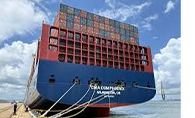Africa and South America now shipping’s new hope as Houthi rockets and US tariffs bite
 As the United States pivots toward economic nationalism, imposing sweeping tariffs and recalibrating trade preferences, the Southern Hemisphere’s once overlooked continents, Africa and South America are quietly stepping into the breach. As the United States pivots toward economic nationalism, imposing sweeping tariffs and recalibrating trade preferences, the Southern Hemisphere’s once overlooked continents, Africa and South America are quietly stepping into the breach.
With new port infrastructure, expanding consumer bases, and a growing portfolio of export-ready commodities, these regions are no longer peripheral players in global trade. They are emerging as viable, competitive alternatives to traditional supply chains, offering international shipping lines fresh opportunities in a world increasingly defined by fragmentation and rerouting.
The recalibration of American trade policy, particularly under the Trump administration’s tariff regime, has sent ripples across the global economy. With ad valorem tariffs ranging from 10 to 50 per cent levied on imports from 190 countries, including 20 African nations, the cost of doing business with the United States has risen sharply.
South Africa, for instance, faces a 30 per cent tariff on its citrus exports, threatening a sector that supports 35,000 jobs and generates over ZAR38 billion (US$2.1 billion) annually. Lesotho’s textile industry, built on the back of African Growth and Opportunity Act (AGOA) preferences, now teeters under a 50 per cent tariff, placing 12,000 jobs at risk.
Yet, amid the disruption lies opportunity. As traditional trade corridors become costlier and more politically fraught, shipping lines are reconfiguring their routes to tap into new markets and circumvent bottlenecks.
Africa, long dismissed, is undergoing a quiet revolution in port infrastructure. Investments in Mombasa, Dar es Salaam, Maputo and Durban are transforming East and Southern Africa into viable maritime gateways.
Durban’s container terminal, which handles 65 per cent of South Africa’s box traffic, is expanding capacity from 2.7 million TEU to 4.5 million TEU over the next decade. Meanwhile, Dar es Salaam, buoyed by a US$345 million World Bank investment, is positioning itself as a regional hub for landlocked countries such as Zambia, Rwanda and the Democratic Republic of Congo.
West Africa is not far behind. Pointe Noire, Luanda, Lagos, Abidjan and Tema near Accra are seeing renewed interest from global terminal operators and shipping lines.
China’s Belt and Road Initiative (BRI) has played a catalytic role, financing deep-water ports, rail corridors and logistics centres that knit together Africa’s fragmented infrastructure.
In Mozambique, the Maputo-Katembe bridge and port upgrades have improved access to hinterland markets, while in Ghana, the expansion of Tema port is enabling larger vessels and higher throughput.
South America, too, is experiencing a maritime renaissance. Major shipping lines are beefing up services to Santos, Buenos Aires, Valparaiso and Callao, recognising the continent’s growing relevance in global supply chains.
Brazil’s Santos port, already the busiest in South America, is undergoing modernisation to handle increased container volumes and facilitate exports of soybeans, machinery and orange juice. Peru’s Chancay port, backed by Cosco, is being positioned as a regional logistics hub, with direct maritime routes to Guangzhou slashing transport costs by nearly 30 per cent.
The Belt and Road’s footprint in South America is expanding, albeit more discreetly. Infrastructure projects such as the proposed transcontinental railway linking Chancay to Brazil’s interior reflect China’s strategic ambition to connect Pacific and Atlantic trade routes. These developments are not merely about logistics—they are about influence, norm-setting and economic realignment.
What makes this moment particularly potent is the convergence of infrastructure investment with demographic and economic transformation. Africa and South America are no longer defined solely by poverty and instability.
The United Nations’ extreme poverty eradication goals, originally set for 2020, were met ahead of schedule in 2013, signalling a turning point. In Africa, the rise of the middle class, urbanisation and digital connectivity are creating new consumer markets. In South America, economic diversification and regional integration are driving demand for efficient trade corridors.
For international shipping, this presents a compelling proposition. These regions offer not only outbound cargo - agricultural produce, horticultural goods, minerals and energy - but also inbound demand for consumer goods, machinery and technology. The asymmetry that once plagued trade with the Global South is narrowing. Santos and Durban are no longer just export terminals—they are nodes in a two-way trade ecosystem.
Of course, challenges remain. Port congestion, regulatory inconsistencies and political risk continue to complicate operations. But the trajectory is clear. As the United States turns inward, Africa and South America are turning outward, investing in connectivity, courting foreign capital and asserting their place in the global trade architecture.
For shipping lines, freight forwarders and logistics providers, the message is unmistakable: the Southern Hemisphere is no longer a detour—it is the destination. |